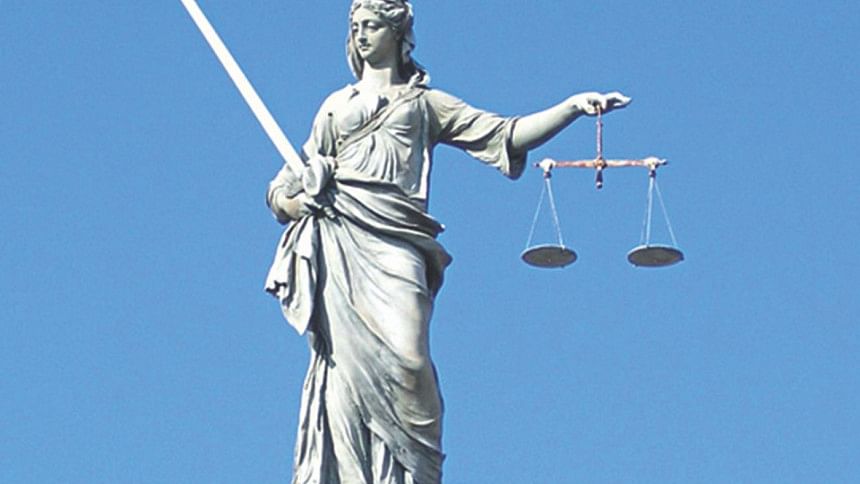The Lady of Justice

My rudimentary knowledge on ancient history dates back to 1997 when having no other choice, I got enrolled in the history department of a public university. My first year there started with ancient history and at one point our course teacher mentioned Themis. Her description was pretty interesting as she was depicted as a symbol of women's empowerment and their capacity to judge better than men. I forgot about Themis shortly after I completed my first year. After all, who cares to remember what you have read when you get passing grade in an academic exam?
I am quite sure that Themis was little known in Bangladesh until Hefajat's demands to remove the newly installed statue of justice from the Supreme Court of Bangladesh surfaced. To my understanding, the statue is not exactly her. Rather the sculptor drew inspiration from her and decided to give her a local image by adorning her with a sari.
A blindfolded lady holding a set of scales is very common in representing justice. It is still unclear who first gave birth of this idea of Goddess of Justice which dates back to ancient times. The ancient Egyptians referred to her as Ma'at – a concept of justice, moral, law and order etc. She used to carry a sword and a feather in her hair but she had no scales. She assisted Osiris in the judgment of the dead by weighing their hearts. The modern world might have adopted the word Magistrate (Latin magistratus) from Ma'at. The ancient Greeks knew her as Themis, who was said to maintain the communal affairs of humans, the assembly (legislature) in particular. She was capable to foresee the future that made her one of the Oracles of Delphi, which ultimately established her as the goddess of divine justice. It is pertinent to mention that in classical representations, Themis was never blindfolded (she could foresee and did not need to be blindfolded). She did not carry a sword either as she represented common consent, not coercion.
Originally, it was the Roman Goddess of Justice, popularly known as Justitia, who was portrayed as blindfolded and balancing scales in one hand and a sword in the other. Sometimes she was portrayed holding a fasces (a bundle of rods around an axe blade) symbolising judicial authority in one hand, and flames symbolising truth in the other. In ancient Rome a Lictor (an officer with magistracy power) used to carry fasces. It had no use other than as a symbol of authority.
Over the course of time, scales and swords came to be closely associated with Justice. Scales represented impartiality and the sword symbolised power. In many inscriptions and art installations of the 16th century, justice was often portrayed blindfolded. The origins of the blindfold are unclear, but it might have been added to portray the law as being objective in determining innocence or guilt without bias or prejudice. Today, the blindfolded lady is accepted as a symbol of impartiality in the judicial system of many countries around the world. Interested readers can have a look at http://mdean.tripod.com/justice.html to see images, statues and sculptures of justice in her various forms.
The point of talking about this history is not to justify whether the statue at the Supreme Court premises should be removed or not, but to put it in a global context. According to the reinstated Constitution of 1972, we take pride in presenting ourselves as a secular country. And it is perhaps not a good omen that a particular organisation (not a political party) which never had representation in any public institution is pointing its finger to the judiciary and denouncing its action. The statue was not installed overnight, nor was it done without proper judgment and approval. In a bizarre incident in 2008, Achin Pakhi, a sculpture representing Lalon and his work was demolished. The same year Balaka – a symbol of our national airlines was badly vandalised. It is still unknown whether we have been able to bring the wrongdoers to book. In addition to such impunity, the Supreme Court's final judgment on Fatwa (fatwa legal only in "religious matters" but cannot be used to punish anyone and violate or affect the rights or reputation or dignity of any person covered by the law of the land) might have angered a section who were waiting for an opportune moment to hit back.
Worshipping an idol is considered a sin in Islam. There is no doubt about it. But displaying a symbol is not as long as nobody is praying to it. We need to understand the difference between an idol (accepted by a religion – Hinduism for instance) and a sculpture (and similar art work). A sculpture as an art work may take inspiration from elements around it. In the first place it is a reflection of thoughts of the artist involved. Sometimes such works cross boundaries and become universal. The sculpture at the Supreme Court premise does not represent any idol. Rather, it is an inspiration and solidarity with the world in its respect for truth and justice. Being a Bangladeshi citizen, I feel that sculptures, arts and installations have been an integral part of our society and culture. It would not be unjust to say that our long struggle for independence has been influenced to a great extent by these. Some more sculptures like Aparajeo Bangla, Swaparjito Swadhinota, Swadhinata Sangram and Raju Bhashkarja are located at a close distance to the Supreme Court. These directly represent our glorious histories of 1952, 1971 and 1990. Can anyone ensure their preservation?
Finally, I don't regret I studied history – it is something everyone should know and cherish impartially, without prejudice.
The writer is communication for Development Professional. He can be reached at [email protected]

 For all latest news, follow The Daily Star's Google News channel.
For all latest news, follow The Daily Star's Google News channel. 



Comments